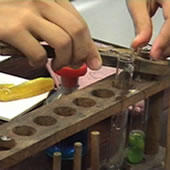Why Singapore’s English Teachers Should Embrace Singlish, Not Fight It
Is it time for Singaporean educators to embrace Singlish as a legitimate learning tool? What the Research […]
Read More
Researchers at the Centre for Research in Pedagogy and Practice (CRPP) recently concluded a pilot study on the design of learning tasks to teach Science Practical Assessment (SPA) skills at the lower secondary level. An innovative approach for involving students as co-participants in SPA through the use of digital video technology is outlined and discussed.

One purpose of the study was to prototype pedagogical methods and materials for use in laboratories.
In this article, we share our experiences of working with a Biology teacher and her students on SPA Skill Set 1: Using and organising techniques, apparatus and materials; and observing, measuring and recording (Ministry of Education, 2005).
SPA replaces the traditional “one-time” assessment taken by students at the GCE Ordinary and Advanced levels.
There are two differences worth noting between the old and new modes of assessment.
Under these conditions, SPA could serve two key purposes in the reformation of science labs in Singapore’s schools.
For these potentials to be realised, Science teachers need to move beyond the administrative practicalities of SPA to consider how the scheme allows students to grow as science practitioners. The following formative performance task illustrates how this can be done.
The following sequence of events was carried out:
Students’ feedback indicated that they understood what was required for SPA Skill Set 1. Their awareness was shown in their ability to pick out details of their classmates’ “good” and “inappropriate” practices during the practical work. The students’ feedback can be categorised into five areas:
Table 1 illustrates some of the students’ comments as they viewed the video clips of their classmates performing the science practical tests.
Table 1: Summary of feedback to students performing practical work (unedited)
| Category | Feedback |
| General planning in carrying out the practical |
|
| Working with the Bunsen burner |
|
| Preparing the sample for experimentation |
|
| Preparing the water bath |
|
| Making observations |
|
The students indicated that they liked this mode of learning because they got to see their friends’ mistakes and learnt from them. Some indicated that they were not able to recognise their own mistakes but others claimed they were able to recognise their errors and correct them. One student indicated that although she gained experience from the mistakes made by others, the class laughed when these occurred. Beyond the specific practical work that the students were supposed to observe, one student indicated that this pedagogy was relevant to her because it helped in the development of a critical eye for details.
The ability of the students to critique practical work in progress, we argue, demonstrates a strength of SPA, as it systematically makes visible to the students how and what they need to be aware of when performing their practical work.
The class critique of the video offered a synergistic environment where the students worked together to improve their science practical skills. As every student in the class performed the same experiment, they could identify with the experiences of their classmates and, hence, were better placed to relate the skills they observed to their own learning.
It is also important to examine the students’ level of readiness for group-critique work. For example, some students indicated that they could not help laughing at the mistakes made by their classmates in the video. The group work and principles of cooperative learning used in this classroom practice need careful planning before they can fulfil the potential that cooperative learning promises.
This study showed that it is possible to examine science practical work from the student’s perspective. The students, as learners of science, were able to cast a critical eye towards what were “good” and “bad” practical skills in the school science lab. We argue that their ability to articulate these moves can form the basis for a deeper understanding of the content of the lower secondary Science curriculum.
Click here to read more about the SPA project.
Also read: Writing to Learn Secondary Science
References
Bernstein, B. (1990). The structuring of pedagogic discourse. London: Routledge.
Ministry of Education. (2005). Update of GCE O-level syllabus for SPA. Singapore: Author.